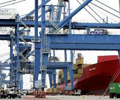Complications for European marine fuel as Russian middle distillate imports fall

Reduced European imports of Russian middle distillates has been leading to complications in marine fuel, with a leading testing agency seeing rising demand for lubricity tests to ensure fuel will not damage engines.
Russia has traditionally been the main supplier of diesel and other middle distillates to Europe but following its invasion of Ukraine and subsequent sanctions the European refining sector has been scrambling to produce more of its own middle distillates.
That has meant a paucity of suitable feedstocks available to blend marine gasoil, which ships mostly use when sailing through International Maritime Organization Emissions Control Areas, such as the Baltic Sea, North Sea and English Channel, to comply with the 0.1% limit on sulfur content in ships’ fuel.
Veritas Petroleum Services said European suppliers may be blending automotive diesel into MGO. That was potentially due to the lack of gasoil coming from Russia, Steve Bee, group commercial & business development director at VPS, said.
Sulfur is a lubricant and automotive diesel has a very low sulfur content, lower than that required for MGO. That means ships’ engines are facing trouble from the lack of sulfur.
“We are seeing an increase in demand for lubricity testing based on the latest revision of [International Standards Organization specifications] ISO2817,” Bee said.
Deliveries of 0.7%S gasoil, a key middle distillates blendstock, from Russia to Europe were set to total 144,260 mt in September. Shipments have been volatile since the invasion of Ukraine but have decreased from 202,983 mt in January and 294,719 mt in September 2021, according to Kpler shipping data.
Impact on VLSFO
The impact of tight gasoil arrivals could also be affecting 0.5%S (very low sulfur) fuel oil, the predominant marine fuel.
Faltering margins for gasoline have been liberating its key feedstock, low sulfur vacuum gasoil, which is finding its way into the bunker pool, resulting in good supply of very low sulfur fuel oil but with some questions around the end product’s properties, according to market sources.
As European refineries crank up diesel output, they are also producing more gasoline. That has resulted in gasoline struggling to find a home. Storage levels in the Amsterdam-Rotterdam-Antwerp trading hub are more than double their average for September 2021 at 1.29 million mt, according to data from Insights Global.
The physical gasoline crack, assessed by Platts — part of S&P Global Commodity Insights — dipped into negative territory at minus 22 cents/b on Sept. 1. The gasoline crack has since recovered to $10.89/b as of Sept. 28, but remained dwarfed by that of diesel, assessed at $47.97/b.
As refiners prioritize diesel yields, gasoline has become almost a byproduct of diesel production, becoming increasingly oversupplied.
“Gasoline is an afterthought when it comes to production,” a Europe-based trader said. “There is no incentive to increase gasoline production at the moment.”
That has meant that LSVGO, which generally goes towards gasoline production, has to find a new home and is an easy fit is 0.5% sulfur fuel oil, the prevalent marine fuel.
Platts assessed EU 0.5%S marine fuel oil cracks — a measure of its profitability versus Dated Brent crude — on Sept. 28 at $4.35/b for October, dropping to $4.20/b for November and rising to $4.56/b for December.
Potential value destruction
A result of more LSVGO finding its way into the bunker pool could be low sulfur marine fuel losing value.
The impact on VLSFO could be a higher pour point, which has already gone up globally from 10 degrees Celsius in January to 15 C currently, possibly due to less gasoil going in for blending, a representative from marine fuels company Integr8 Fuels told S&P Global. The resulting VLSFO may require more heating to store, particularly going into the winter.
Add to that the fact that VGO is paraffinic, whereas bunker fuel is usually aromatic, and stability issues “may become trickier to avoid when using VGO components with other aromatic blending components,” the representative said.
Source: Platts

 Hellenic Shipping News Worldwide Hellenic Shipping News Worldwide, Online Daily Newspaper on Hellenic and International Shipping
Hellenic Shipping News Worldwide Hellenic Shipping News Worldwide, Online Daily Newspaper on Hellenic and International Shipping





















 PG-Software
PG-Software